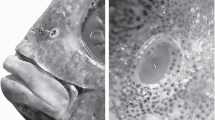Summary
Vibratile urnae of Leptosynapta inhaerens are organized in three longitudinal bands along the mesenteries. An individual of 10 cm length usually houses about 4500 urnae. These are minute (300 Gmm high), S-shaped and hollow peritoneal organs consisting of an intracoelomic projection of the body wall mesothelium supported by a thin connective tissue layer. The urnal cavity is strongly ciliated. Each urna harbours a clump of coelomocytes at the lower part of its aperture. The clump is attached to the urna through spot-like desmosomes occurring between its inner-most coelomocytes and apical urnal cells. Clumps and urnae form functional units. Urnal cilia produce steady water currents through urnal cavities and whirls along urnal bands. The particulate material conveyed by the coelomic fluid enters the urnal cavity and is either trapped by coelomocyte pseudopodia or agglutinated by a mucoid substance that covers the clump's outer surface. Depending on individuals, clearance of coelomic fluid occurs from 2 to 3 h after experimental injection of particulate material. The effectiveness of coelomic fluid clearance appears to be due to the particular organization and location of urnae, viz. in longitudinal bands along the mesenteries.
Similar content being viewed by others
References
Brisou J (1971) Techniques d'Enzymologie bactérienne. Masson & Cie (eds) Paris, pp 286
Clark HL (1899) The synaptas of the New England coast. Bull US Fish Comm 19:21–31
Clark HL (1907) The apodous holothurians. A monograph of the Synaptidae and Molpadidae. Smithson Contrib Knowl 35:1–231
Cuénot L (1891) Etudes morphologiques sur les échinodermes. Arch Biol 11:313–680
Cuénot L (1902) Organes agglutinants et organes cilio-phagocy-taires. Arch Zool Exp Gén 10:79–97
Gabe M (1968) Techniques histologiques. Masson (ed) Paris, pp 1113
Heding SG (1928) Synaptidae. Vidensk Medd Dan Naturhist Foren 85:105–323
Hill RB, Reinschmidt D (1976) Relative importance of propylene phenoxetol in its action as a “preservative” for living holothurians. J Invertebr Pathol 28:131–135
Hyman LH (1955) The Invertebrates. Vol. IV: Echinodermata, the coelomate bilateria. McGraw-Hill: New York, pp 763
Richardson KC, Jarrett L, Finke EK (1960) Embedding in epoxy resins for ultrathin sectioning in electron microscopy. Stain Technol 35:313–323
Scherrer (1984) Biostatistique. Gaëtan Morin (ed). Chicoutimi (Québec)
Schultz E (1895) Über den Prozeß der Exkretion bei den Holothurien. Biol Zentralbl 15:390–398
Semon R (1886) Beiträge zur Naturgeschichte der Synaptiden des Mittelmeers. 1. & 2. Mittheilung. Mitt Zool Sta Neapel 7:272–300
Author information
Authors and Affiliations
Rights and permissions
About this article
Cite this article
Jans, D., Jangoux, M. Functional morphology of vibratile urnae in the synaptid holothuroid Leptosynapta inhaerens (Echinodermata). Zoomorphology 109, 165–171 (1989). https://doi.org/10.1007/BF00312268
Received:
Issue Date:
DOI: https://doi.org/10.1007/BF00312268




